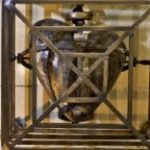Croí Lorcán Uí Thuathail (The Heart of St. Laurence O’Toole) Posted by róislín on Mar 4, 2012 in Irish Language
(le Róislín)
Bhuel, mí an Mhárta may be the “sure-they’d-steal-your-heart-away” month, as “Irish Eyes” is sung over and over and over again, but I doubt it was ever meant to be taken literally.
But that’s exactly what has happened recently. The theft of St. Laurence O’Toole’s heart apparently occurred on the morning of March 3rd. The heart, stored in a wooden heart-shaped box, was taken from its barred cage in the Peace Chapel of St. Laud in Christ Church Cathedral. The Cathedral, described as “the spiritual heart of the city,” was founded ca. 1028, about a hundred years before the birth of the saint. The heart has been kept there for about 800 years. There’s plenty to read online about the incident but here’s a nasc for starters: http://www.christchurchdublin.ie/NewsDetails/72.
Meanwhile, seo capsúlbheathaisnéis Lorcán Uí Thuathail:
1128: rugadh é i nDíseart Diarmada (Castledermot), Co. Chill Dara
1154: ceapadh é mar ab ar Ghleann Dá Loch
1162: toghadh é mar Ardeaspag ar Bhaile Átha Cliath
1180 (14 Mí na Samhna, a lá féile anois): fuair sé bás sa Fhrainc, in Eu sa Normainn
1225 (11 Mí na Nollag): canónadh é
1442: tógadh a chloigeann agus a chnámha go Sasana agus cuireadh i Chorley, Lancashire, iad, ach cailleadh iad in am Anraí VIII. Ní fhacthas ó shin iad.
2012 (3 Mí an Mhárta): goideadh a chroí ó Ardeaglais Chríost
Given that he lived about 600 years after most of the well-known Irish saints, in a (somewhat) more modern era, Lorcán Ua Tuathail’s life is quite well documented in comparison. Desmond Forristal’s biography, Man in the Middle: St. Laurence O’Toole: Patron Saint of Dublin (1988) is a good place to start for further insight into his life.
From the perspective of Irish language learning, there are a few interesting points about Lorcán Ua Tuathail’s name. First, one might notice right away that he is not referred to as “Labhrás,” which is the usual Irish for “Laurence” and is also the Irish for the 3rd-century San Labhrás (na Róimhe). I assume that the name was anglicized as Laurence in honor St. Laurence of Rome, although there’s no real connection between the names. Lorcán, as a name, means “silent” or “fierce,” but it’s not the everyday word for “silent” or “fierce” in modern Irish. Cad iad i nGaeilge? Féach an nóta thíos. Its appearance in the Harry Potter series may trigger greater interest in the name as the 21st century proceeds. Where in Harry Potter, you might wonder? Bhuel, not in the actual books, but apparently in a family tree drawn by J. K. Rowling herself, which you can see at: http://www.snitchseeker.com/gallery/displayimage.php?pos=-11259 . No “fada,” by the way – I checked. The Lorcan connection was revealed in an interview with Rowling. He is the son of Rolf Scamander and Luna Lovegood, and the twin of Lysander Scamander. For details on the interview, see: http://www.imdb.com/title/tt1071246/.
Second, “Ua,” as the middle component of his name is an alternate to the more familiar “Ó.” Both words mean “grandson” or “descendant.” Of course, “ó” isn’t the everyday word for “grandson” either – that would be “garmhac.” Aside from their use in surnames, “ó” and “ua,” together with their plural and/or dative forms “óí,” “uí,” and “uíbh,” are used mostly in literary, historical, and geographic (place name) contexts these days, as in “Uí Néill” (the descendants of Niall Naoighiallach) or “Uíbh Ráthach” (Iveragh, Co. Kerry).
Thirdly, when the surname “Ua Tuathail” or “Ó Tuathail” is part of a possessive phrase, it becomes “Uí Thuathail,” with a vowel change and lenition. So we have phrases like “croí Lorcán Uí Thuathail,” or more generally “in aimsir Uí Thuathail” (in the time of O’Toole). Likewise, the “Ó” of other modern surnames changes, as in “Bean Uí Dhónaill” (Mrs. O’Donnell, lit. wife of O’Donnell) or “Sráid Uí Chonaill” (O’Connell Street). So, the grammar/spelling caveat is that “uí” can be plural or it can be the singular possessive form. This isn’t unusual in Irish, as in “fir” (men) and “fir” (of a man) or “báid” (boats) and “báid” (of a boat).
As for the lenition, we see the additional “h” in the name “Tuathail” [TOO-uh-hil] It becomes “Thuathail,” pronounced “HOO-uh-hil.” At the risk of being obvious, I could also note that “Tuathail” usually has three syllables in Irish, whereas the anglicized version has just one (Toole).
A final interesting note — “Lorcán” is a shoo-in for a name in any O’Toole family, and I wonder what it’s like to bear it. Peter O’Toole’s son, also an actor, is named Lorcan O’Toole. Cad a shíleann seisean, meas tú? Hmmm, Gaeilge aige, meas tú? Peter himself is actually “Peter Seamus Lorcan O’Toole.” I just checked and he was born in August 2nd, not on St. Laurence O’Toole’s feast day (14 Mí na Samhna), so I’m curious as to how he ended up with Lorcán in his name. Eolas ag duine ar bith? Duine dena sheanaithreacha, b’fhéidir? Ironic, isn’t it, that Peter O’Toole rose to fame as a “Labhrás” of another ilk altogether. Na hAraibe, ar ndóigh.
At any rate, this blog is, ar ndóigh, just the usual tip of the iceberg of information about this interesting and well-documented saint, the recent and appalling theft of his heart, and the names “Lorcán” and “Ó Tuathail” in general. Tá súil agam go raibh sé suimiúil. As for the gadaíocht í féin, what a way to welcome in an mhí is Éireannaí sa bhliain!
Nóta: fierce: fíochmhar, fraochmhar, díocaiseach, srl., and silent: tostach, ciúin, srl.

Build vocabulary, practice pronunciation, and more with Transparent Language Online. Available anytime, anywhere, on any device.





Leave a comment: